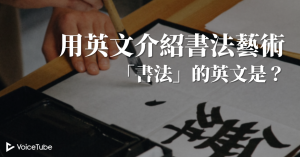大家小時候學過書法嗎?
「楷書」的英文該怎麼說?
又要怎麼用英文說明毛筆的拿法呢?
看看 Brian 怎麼用英文跟 Hank 介紹博大精深的書法藝術吧!

Brian 跟外國朋友 Hank 看完書法展後,Hank 因為愛上了書法,便開口請 Brian 教他。
Brian: Alright! Let’s start from the most basic part, holding the brush.
Brian: 好,我們先從最基本的開始—握筆。Hank: That’s a piece of cake! My handwriting is neat and I think I have a talent for Chinese calligraphy.
Hank: 這太簡單了!我寫字可是很工整的,我覺得我很有寫書法的天分。Brian: No, it’s totally different from holding a pencil. You have to use your ring finger, middle finger and thumb to grip the brush. Remember to hold it vertically.
Brian: 不,這完全跟拿筆的方式不一樣,要用你的無名指、中指跟大拇指握筆,而且毛筆一定要垂直。Hank: But my hand will shake if I hold it like this.
Hank: 但這樣握的話我的手會抖耶。Brian: That’s why we need to practice! Next is the ink.
Brian: 所以才要練習啊!再來是墨水。Hank: Where? I only see two stones. They are as black as coal.
Hank: 在哪?我只看到兩塊石頭,跟煤炭一樣黑。Brian: They are inkstick and inkstone. First we need to dip some water onto the inkstone, and then use the inkstick to grind against it.
Brian: 它們就是墨條跟硯台。首先我們要先滴幾滴水在硯台上,接著再用墨條在上面磨墨。Hank: Calligraphy is quite an art!
Hank: 書法真的是一門學問呀!
Hank 最後能不能寫出一手好字呢?先複習單字吧!
brush (n.) 毛筆
brush 當名詞時原本意思為「刷子;畫筆」,在書法藝術中則可用來指「毛筆」,也可以在前面加上 Chinese 來強調。
When you clean the brush, the flow of the water has to follow the direction of the brush hairs.
洗筆時,水流的流向要順著筆毛的方向。
handwriting (n.) 字跡
handwriting 就是指寫字的「字跡;筆跡」。
It’s said that if your handwriting is messy, you are an intelligent and creative person.
據說如果你的字跡很潦草,你就是個聰明、富有創意的人。
calligraphy (n.) 書法
calligraphy 意指「書法」,不只中國有書法,西方國家也有!像安瑟爾體 (Uncial)、哥德體 (Gothic) 都是西洋書法。如果要特別強調「中國書法」,一樣可以在前面加上Chinese。
She got the hang of Chinese calligraphy very quickly.
她馬上就抓到了寫書法的訣竅。
inkstick (n.) 墨條 inkstone (n.) 硯台
inkstick 就是「墨條」,inkstone 則是「硯台」,「磨墨」的動詞用 grind (注意動詞三態為不規則 grind-ground-ground)。補充:寫書法時雖可直接用墨汁 (ink),但許多講究的人認為墨汁的寫感、色澤都不如磨出來的墨好。
Grinding an inkstick against an inkstone is a way to calm your mind before doing calligraphy.
寫書法前,用墨條磨墨可以讓你靜下心來。
萬事俱備後,Hank 跟 Brian 就要開始寫書法啦!
Hank: Phew! Everything is ready! What are we going to write?
Hank: 呼!都準備好了!我們要寫些什麼呢?Brian: We can start from some simple characters like 小、中、大. (pointing at the copybook)
Brian: 我們可以些從一些簡單的字開始,像是「小、中、大」。(指著字帖)Hank: That looks very easy! (trying to write 小)
Hank: 這看起來很簡單!(試著寫「小」)Brian: Pay attention the stroke order! We are not always writing from left to right. For example, when you write 小, you have to start from the center.
Brian: 注意筆順!我們不一定是從左到右寫,比方說你在寫「小」這個字,就要先寫中間的部分。Hank: I can’t believe this is so damn hard! By the way, we saw a very cool script style at yesterday’s exhibition. It looked like snakes. Do you have that copybook?
Hank: 真不敢相信書法怎麼可以這難!對了,昨天我們在展覽有看到一個很酷的字體風格,長得像蛇一樣,你有那種字體的字帖嗎?Brian: It’s called cursive script but that is for more advanced learners. For beginners like you, you have to start from regular script.
Brian: 那叫做草書,是較進階的人在學的。對你這種初學者來說,還是要先從楷書開始。Hank: Fine. It seems that I have a long way to go.
Hank: 好吧,看來我還有好長一段路要走。
各種藝術,包含書法都並非一蹴可幾,希望 Hank 可以堅持下去囉!
copybook (n.) 字帖
小時候學寫字時都會有字帖讓我們跟著臨摹,而「字帖」的英文就叫 copybook,此字由 copy + book 組合而成,其中 copy 有「模仿」的意思。
Many kids practice writing with copybooks.
許多小孩都是用字帖練習寫字。
stroke order (n.) 筆順
stroke 當名詞時常見的意思為「中風」,此外還可以指寫字或畫畫的「一筆」,因此 stroke order 就是指「筆順」。
Stroke order is one of the most difficult parts of learning Chinese characters for foreign learners.
對學中文的外國人來說,筆順是其中一個最困難的部分。
cursive script (n.) 草書 regular script (n.) 楷書
script 有「劇本;字跡」之意,「草寫」用 cursive 來形容,中文的「草書」也挪用了這個字,稱做 cursive script,而一般常見的「楷書」則是 regular script。
Regular script is the most commonly published type while cursive script is rarely seen.
楷書是出版刊物中最常見的字體,草書則非常少見。
許多外國人其實都對中華文化像是太極、功夫、書法很感興趣,有機會你也可以讓外國朋友體驗書法藝術唷!
迫不及待想馬上開始練習嗎?
快打開 VoiceTube App 練英文!
✦ 立即下載 >>> https://bit.ly/myenglishissogood
英文單字不要硬背! 藉由 VoiceTube App 看影片,不會的單字反覆聆聽,加上單字測驗練習,聽寫齊下,立刻熟記!
文/ Vivian Chen
審/ Eunice Lin
圖/ Unsplash
作者簡介/ VoiceTube 看影片學英語
《Ride the Vibes 脈搏秀》VoiceTube 原創 Podcast 於 iTunes、Spotify 雙平台上線了!快點擊下方連結下載收聽!
iTunes:https://apple.co/38h1b6j
Spotify:https://spoti.fi/2GSR1wE
